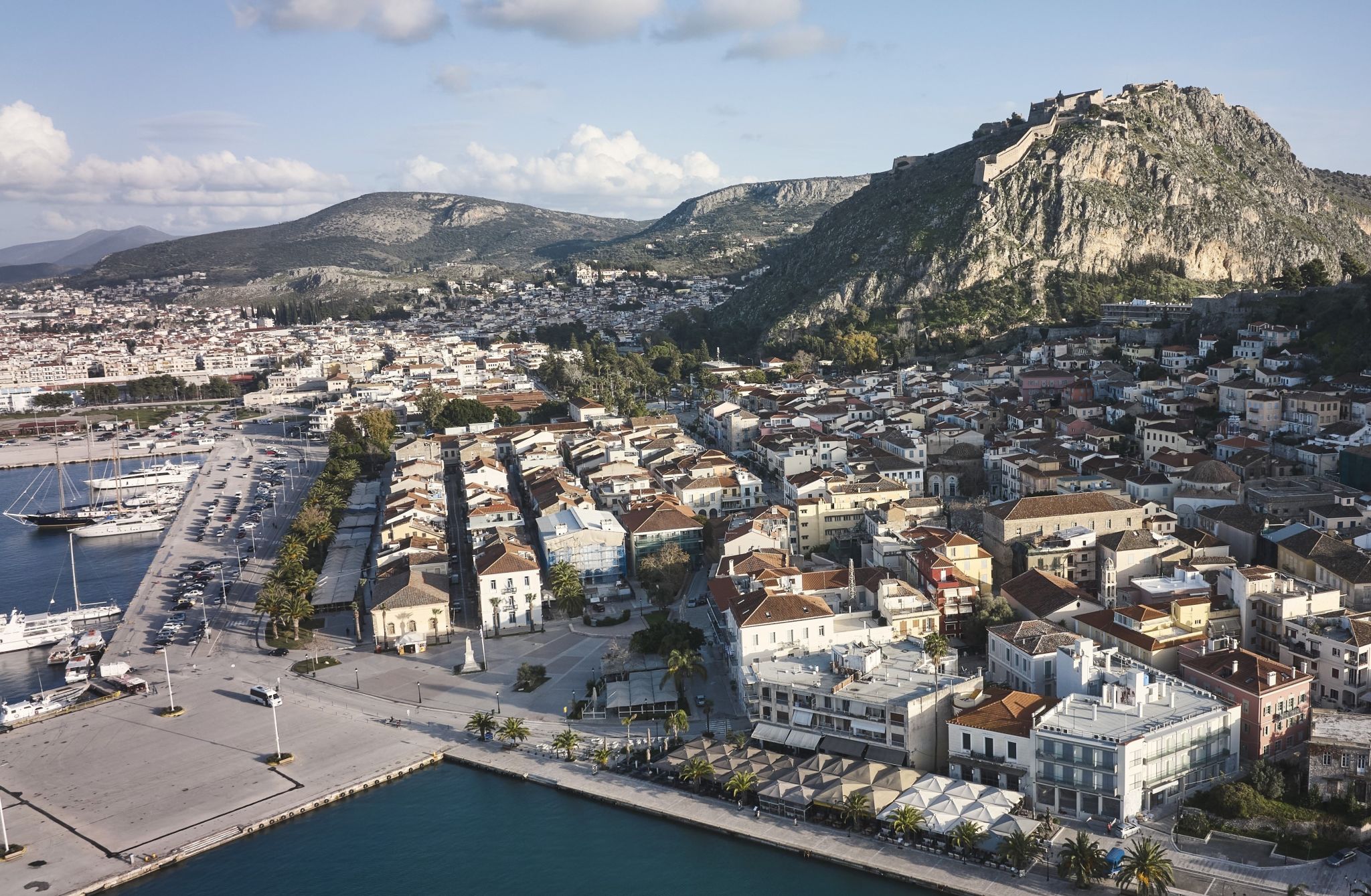NAFPLIO

Nafplio is the city that you should not deprive yourself from visiting even once in your lifetime.
Because Nafplio is the place where:
The historical past becomes alive
The ancient culture awakens the spirit
The tradition remains indelible
The authenticity is a fact
The nobility is diffused
The beauty is breathtaking
The adventure gives life
The sun embraces the sea
The hugs and smiles warm the soul
The romance creates love
The music instinctively comes out of your lips, and
The body spontaneously dances
Nafplio (Modern Greek: Ναύπλιο, Nafplio) is a seaport town in the Peloponnese in Greece that has expanded up the hillsides near the north end of the Argolic Gulf. The town was the capital of the First Hellenic Republic, from the start of the Greek Revolution in 1821 until 1834. Nafplio is now the capital of the regional unit of Argolis. The name of the town changed several times over the centuries. The contemporary Greek name of the town is Nafplio (Ναύπλιο).In modern English, the most frequently used forms are Nauplia and Navplion.
During the Classical Antiquity, it was known as Nauplia (Ναυπλία) in Attic Greek and Naupliē (Ναυπλιη) in Ionian Greek. In Latin, it was called Nauplia.
During the middle Ages, several variants were used in Byzantine Greek, including Náfplion (Ναύπλιον), Anáplion (Ἀνάπλιον), and Anáplia (Ἀνάπλια).
During the Late Middle Ages and Early Modern period, under Venetian domination, the town was known in Italian as Napoli di Romania, after the medieval usage of “Romania” to refer to the lands of the Byzantine Empire, and to distinguish it from Napoli (Naples) in Italy.
Also during the Early Modern period, but this time under Ottoman rule, the Turkish name of the town was Mora Yenişehri, after Morea, a medieval name for the Peloponnese, and “yeni şehir,” the Turkish term for “new city” (apparently a translation from the Greek Νεάπολη, Italian Napoli). The Ottomans also called it Anabolı. In the 19th century and early 20th century, the town was called indiscriminately Náfplion (Ναύπλιον) and Nafplio (Ναύπλιο) in modern Greek. Both forms were used in official documents and travel guides. This explains why the old form Náfplion (sometimes transliterated to Navplion) still occasionally survives up to this day.
Classical Antiquity
The area surrounding Nafplio has been inhabited since ancient times, but few signs of this remain visible. The town has been a stronghold on several occasions during Classical Antiquity. It seems to be mentioned on an Egyptian funerary inscription of Amenophis III as Nuplija.
Middle Ages
Nafplion, or Napoli di Romania, in the mid-16th century.
The Acronauplia has walls dating from pre-classical times. Subsequently, Byzantines, Franks, Venetians, and Turks added to the fortifications. Nafplio was taken in 1212 by the French crusaders of the Principality of Achaea, then in 1388 was sold to the Republic of Venice. During the subsequent 150 years, the lower city was expanded and fortified, and new fortifications added to Acronauplia.
Early Modern
The city surrendered to the Ottomans in 1540, who renamed it Mora Yenişehri and established it as the seat of a sanjak. At that period, Nafplio looked very much like the 16th century image shown below to the right.
The Venetians retook Nafplio in 1685 and made it the capital of their “Kingdom of the Morea”. The Venetians strengthened the city by building the castle of Palamidi, which was in fact the last major construction of the Venetian empire overseas. However, only 80 soldiers were assigned to defend the city and it was easily retaken by the Ottomans in 1715. Palamidi is located on a hill north of the old town. During the Greek War of Independence, it played a major role. It was captured by Staikos Staikopoulos in November 1822.
19th Century
The castle of Palamidi; was used as a prison cell for Theodoros Kolokotronis.
Ioannis Kapodistrias’ murder.
During the Greek War of Independence, Nafplio was a major Ottoman stronghold and was besieged for more than a year. The town finally surrendered because of starvation. After its capture, because of its strong fortifications, it became the seat of the provisional government of Greece.
Count Ioannis Kapodistrias, first head of state of newly liberated Greece, set foot on the Greek mainland for the first time in Nafplio on 7 January 1828 and made it the official capital of Greece in 1829. He was assassinated on 9 October 1831 by members of the Mavromichalis family, on the steps of the church of Saint Spyridon in Nafplio. After his assassination, a period of anarchy followed, until the arrival of King Otto and the establishment of the new Kingdom of Greece. Nafplio remained the capital of the kingdom until 1834, when King Otto decided to move the capital to Athens.
20th and 21st Centuries
Plateia Syntagmatos (Constitution Square).
A street of Nafplio.
Nafplio promenade.
Tourism emerged slowly in the 1960s, but not to the same degree as some other Greek areas. Nevertheless, it tends to attract a number of tourists from Germany and the Scandinavian countries in particular. Nafplio enjoys a very sunny and mild climate, even by Greek standards, and as a consequence has become a popular day or weekend road-trip destination for Athenians in wintertime.
Nafplio is a port, with fishing and transport ongoing, although the primary source of local employment currently is tourism, with two beaches on the other side of the peninsula from the main body of the town and a large amount of local accommodation. There are frequent bus services from/to Athens (KTEL).
The building of the National Bank of Greece is probably the only one in the world to have been built in the Mycenaean Revival architectural style.
Because Nafplio is the place where:
The historical past becomes alive
The ancient culture awakens the spirit
The tradition remains indelible
The authenticity is a fact
The nobility is diffused
The beauty is breathtaking
The adventure gives life
The sun embraces the sea
The hugs and smiles warm the soul
The romance creates love
The music instinctively comes out of your lips, and
The body spontaneously dances
Nafplio (Modern Greek: Ναύπλιο, Nafplio) is a seaport town in the Peloponnese in Greece that has expanded up the hillsides near the north end of the Argolic Gulf. The town was the capital of the First Hellenic Republic, from the start of the Greek Revolution in 1821 until 1834. Nafplio is now the capital of the regional unit of Argolis. The name of the town changed several times over the centuries. The contemporary Greek name of the town is Nafplio (Ναύπλιο).In modern English, the most frequently used forms are Nauplia and Navplion.
During the Classical Antiquity, it was known as Nauplia (Ναυπλία) in Attic Greek and Naupliē (Ναυπλιη) in Ionian Greek. In Latin, it was called Nauplia.
During the middle Ages, several variants were used in Byzantine Greek, including Náfplion (Ναύπλιον), Anáplion (Ἀνάπλιον), and Anáplia (Ἀνάπλια).
During the Late Middle Ages and Early Modern period, under Venetian domination, the town was known in Italian as Napoli di Romania, after the medieval usage of “Romania” to refer to the lands of the Byzantine Empire, and to distinguish it from Napoli (Naples) in Italy.
Also during the Early Modern period, but this time under Ottoman rule, the Turkish name of the town was Mora Yenişehri, after Morea, a medieval name for the Peloponnese, and “yeni şehir,” the Turkish term for “new city” (apparently a translation from the Greek Νεάπολη, Italian Napoli). The Ottomans also called it Anabolı. In the 19th century and early 20th century, the town was called indiscriminately Náfplion (Ναύπλιον) and Nafplio (Ναύπλιο) in modern Greek. Both forms were used in official documents and travel guides. This explains why the old form Náfplion (sometimes transliterated to Navplion) still occasionally survives up to this day.
Classical Antiquity
The area surrounding Nafplio has been inhabited since ancient times, but few signs of this remain visible. The town has been a stronghold on several occasions during Classical Antiquity. It seems to be mentioned on an Egyptian funerary inscription of Amenophis III as Nuplija.
Middle Ages
Nafplion, or Napoli di Romania, in the mid-16th century.
The Acronauplia has walls dating from pre-classical times. Subsequently, Byzantines, Franks, Venetians, and Turks added to the fortifications. Nafplio was taken in 1212 by the French crusaders of the Principality of Achaea, then in 1388 was sold to the Republic of Venice. During the subsequent 150 years, the lower city was expanded and fortified, and new fortifications added to Acronauplia.
Early Modern
The city surrendered to the Ottomans in 1540, who renamed it Mora Yenişehri and established it as the seat of a sanjak. At that period, Nafplio looked very much like the 16th century image shown below to the right.
The Venetians retook Nafplio in 1685 and made it the capital of their “Kingdom of the Morea”. The Venetians strengthened the city by building the castle of Palamidi, which was in fact the last major construction of the Venetian empire overseas. However, only 80 soldiers were assigned to defend the city and it was easily retaken by the Ottomans in 1715. Palamidi is located on a hill north of the old town. During the Greek War of Independence, it played a major role. It was captured by Staikos Staikopoulos in November 1822.
19th Century
The castle of Palamidi; was used as a prison cell for Theodoros Kolokotronis.
Ioannis Kapodistrias’ murder.
During the Greek War of Independence, Nafplio was a major Ottoman stronghold and was besieged for more than a year. The town finally surrendered because of starvation. After its capture, because of its strong fortifications, it became the seat of the provisional government of Greece.
Count Ioannis Kapodistrias, first head of state of newly liberated Greece, set foot on the Greek mainland for the first time in Nafplio on 7 January 1828 and made it the official capital of Greece in 1829. He was assassinated on 9 October 1831 by members of the Mavromichalis family, on the steps of the church of Saint Spyridon in Nafplio. After his assassination, a period of anarchy followed, until the arrival of King Otto and the establishment of the new Kingdom of Greece. Nafplio remained the capital of the kingdom until 1834, when King Otto decided to move the capital to Athens.
20th and 21st Centuries
Plateia Syntagmatos (Constitution Square).
A street of Nafplio.
Nafplio promenade.
Tourism emerged slowly in the 1960s, but not to the same degree as some other Greek areas. Nevertheless, it tends to attract a number of tourists from Germany and the Scandinavian countries in particular. Nafplio enjoys a very sunny and mild climate, even by Greek standards, and as a consequence has become a popular day or weekend road-trip destination for Athenians in wintertime.
Nafplio is a port, with fishing and transport ongoing, although the primary source of local employment currently is tourism, with two beaches on the other side of the peninsula from the main body of the town and a large amount of local accommodation. There are frequent bus services from/to Athens (KTEL).
The building of the National Bank of Greece is probably the only one in the world to have been built in the Mycenaean Revival architectural style.


